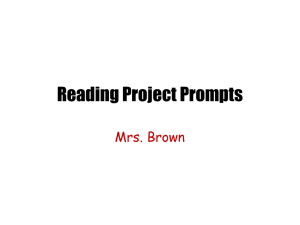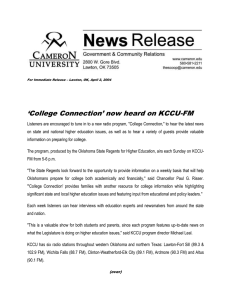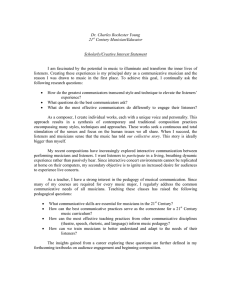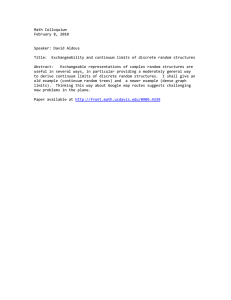Perception of intraphonemic differences by phoneticians,
advertisement
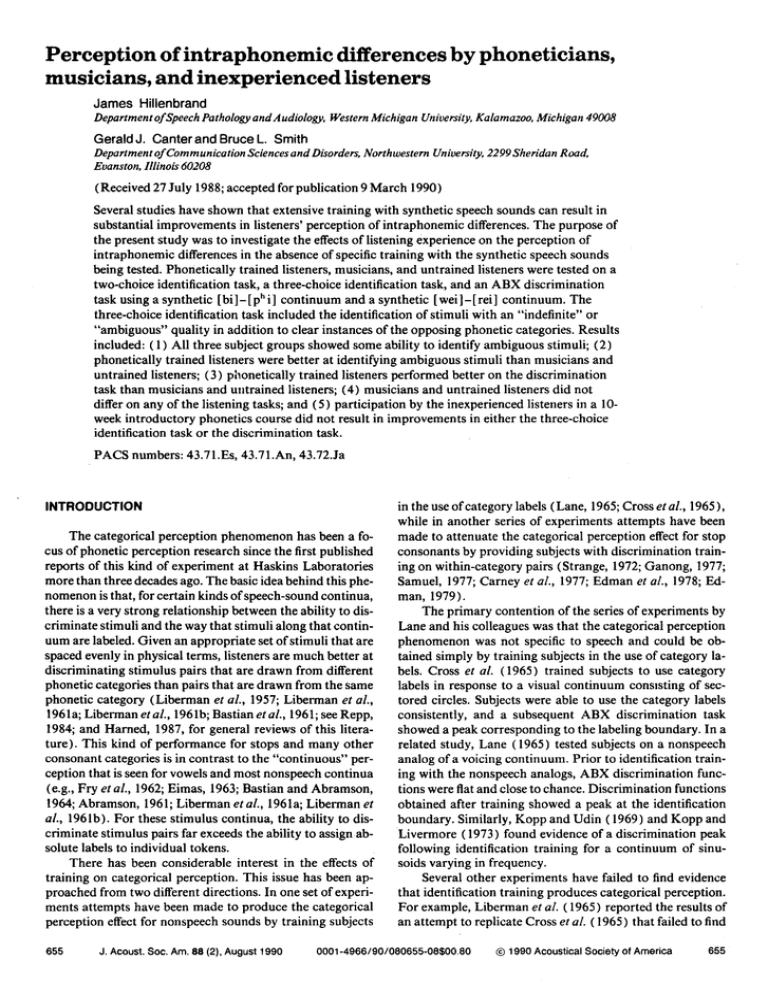
Perception of intraphonemic differences by phoneticians,
musicians, and inexperienced listeners
James
Hillenbrand
DepartmentofSpeech
Pathology
andAudiology,Western
MichiganUniversity,
Kalamazoo,Michigan49008
Gerald J. Canter and Bruce L. Smith
Departmentof Communication
Sciences
andDisorders,
Northwestern
University,
2299SheridanRoad,
Evanston, Illinois 60208
( Received
27July1988;accepted
forpublication
9 March 1990)
Severalstudieshaveshownthat extensivetrainingwith syntheticspeechsoundscanresultin
substantialimprovements
in listeners'perceptionof intraphonemicdifferences.
The purposeof
the presentstudywasto investigate
theeffectsof listeningexperience
on theperception
of
intraphonemicdifferences
in the absence
of specifictrainingwith the syntheticspeechsounds
beingtested.Phoneticallytrainedlisteners,musicians,and untrainedlistenersweretestedon a
two-choiceidentificationtask, a three-choiceidentificationtask, and an ABX discrimination
taskusinga synthetic
[bi]-[p hi] continuum
anda synthetic
[wei]-[rei] continuum.
The
three-choice identification task included the identification of stimuli with an "indefinite" or
"ambiguous"qualityin additionto clearinstances
of the opposingphoneticcategories.
Results
included:( 1) All threesubjectgroupsshowedsomeability to identifyambiguous
stimuli;(2)
phoneticallytrainedlistenerswerebetterat identifyingambiguous
stimulithan musicians
and
untrainedlisteners;(3) phoneticallytrainedlistenersperformedbetteron the discrimination
task than musiciansand untrained listeners;(4) musiciansand untrained listenersdid not
differon any of the listeningtasks;and (5) participationby the inexperiencedlistenersin a 10week introductoryphoneticscoursedid not resultin improvementsin either the three-choice
identification
task or the discrimination
task.
PACS numbers:43.71.Es, 43.71.An, 43.72.Ja
INTRODUCTION
in theuseof categorylabels(Lane, 1965;Crossetal., 1965),
while in anotherseriesof experimentsattemptshave been
The categoricalperceptionphenomenon
hasbeena fomadeto attenuatethe categoricalperceptioneffectfor stop
cusof phoneticperception
research
sincethefirstpublished consonants
by providingsubjects
with discrimination
trainreportsof thiskind of experimentat HaskinsLaboratories ing on within-category
pairs(Strange,1972;Ganong,1977;
morethanthreedecades
ago.The basicideabehindthispheSamuel,1977;Carney et al., 1977;Edman et al., 1978;Ednomenonisthat,for certainkindsof speech-sound
continua, man, 1979).
thereisa verystrongrelationship
betweentheabilityto discriminatestimuliandthewaythatstimulialongthatcontinuumarelabeled.Givenan appropriate
setof stimulithatare
spacedevenlyin physicalterms,listenersare muchbetterat
discriminating
stimuluspairsthat are drawnfrom different
phoneticcategories
than pairsthat aredrawn from the same
phoneticcategory(Liberman et al., 1957;Libermanet al.,
1961a;Libermanetal., 1961b;Bastianetal., 1961;seeRepp,
1984; and Harned, 1987, for generalreviewsof this literature). This kind of performancefor stopsand many other
consonantcategoriesis in contrastto the "continuous"perceptionthat isseenfor vowelsandmostnonspeech
continua
(e.g.,Fry et al., 1962;Eimas,1963;BastJan
andAbramson,
1964;Abramson,1961;Libermanet aL, 1961a; Libermanet
aL, 1961b).For thesestimuluscontinua,the abilityto discriminatestimuluspairsfar exceedsthe abilityto assignabsolute labels to individual
tokens.
There has been considerable interest in the effects of
training on categoricalperception.This issuehas beenapproachedfrom two differentdirections.In onesetof experimentsattemptshavebeenmade to producethe categorical
perceptioneffectfor nonspeech
soundsby trainingsubjects
655
J. Acoust.Soc.Am.88 (2), August1990
The primarycontention
of the seriesof experiments
by
Laneandhiscolleagues
wasthat the categoricalperception
phenomenonwas not specificto speechand couldbe obtainedsimplyby trainingsubjectsin the useof categorylabels. Cross et al. (1965) trained subjectsto use category
labelsin responseto a visualcontinuumconsistingof sectored circles.Subjectswere able to usethe categorylabels
consistently,and a subsequentABX discriminationtask
showeda peakcorresponding
to the labelingboundary.In a
relatedstudy,Lane (1965) testedsubjectson a nonspeech
analogof a voicingcontinuum.Prior to identificationtraining with the nonspeech
analogs,ABX discrimination
functions were flat and close to chance. Discrimination functions
obtainedafter trainingshoweda peak at the identification
boundary.Similarly,Kopp and Udin (1969) and Kopp and
Livermore(1973) foundevidence
of a discrimination
peak
followingidentificationtraining for a continuumof sinusoidsvarying in frequency.
Severalother experimentshave failed to find evidence
that identificationtrainingproducescategoricalperception.
For example,Libermanet al. (1965) reportedthe resultsof
an attemptto replicateCrosset al. (1965) that failedto find
0001-4966/90/080655-08500.80
¸ 1990 AcousticalSocietyof America
655
evidence
of discrimination
peaks for a visualcontinuum
either beforeor after identificationtraining.A secondfailure
to replicateCrosset aL wasreportedby Parkset al. (1969).
Evidencefor the effectiveness
of techniques
designedto
attenuatecategorical
perception
effectsthroughdiscriminationtrainingseems
to bemoreclear.Hanson(1977) reported a largeincreasein within-category
discriminationperformanceasa resultof instructingsubjectsto attendcarefullyto
small differencesbetweenstimuli and providing feedback
throughouta same--different
reaction-timetask.A reportby
Repp (1975) suggests
thatit wasprimarilythefeedbackthat
wasresponsible
for the increasein performance.Repp'slistenersweregiventhesameinstructions
andtaskbut without
feedback,and showedno improvementin within-category
performance.Strange (1972) reported only a small improvementin performanceafter extensivediscrimination
training with feedback.Repp (1984) and Carney et aL
(1977) attributed the relatively modestperformanceimprovementin Strange'sstudyto the high stimulusuncertainty of the oddity taskthat wasused.In supportof this contention, Repp citesthe excellentwithin-categoryperformance
reportedby Sachsand Grant (1976) and Ganong (1977),
whoprovidedfeedbackto subjects
andreducedstimulusuncertaintyby presenting
same-different
trialsin blocksthat
contrastedonly two stimuli.
The mostcompletesetof data regardingthe effectsof
trainingon theperceptionofintraphonemicdifferences
consistsof a seriesof experiments
conductedat theUniversityof
Minnesota.Carneyet al. (1977) testedsubjectsbothbefore
and after extensivediscriminationtraining usinga fixedstandard,same-differentprocedureand an oddity paradigm. The resultsfor both procedures
showedlarge improvementsin within-categoryperformancefollowing
training.Follow-upstudiesshowedthat trainingon a [blIp] continuumtransferredreadilyto a [g]-[k] continuum
(Edmanet al., 1978), and that trainingon a [b]-[d]-[g]
continuumtransferredto a [p]-[t]-[k]
continuum (Edman, 1979).
Carney et al. also showedthat providingappropriate
feedbackto subjectsallowedlistenersto assigncategorylabelsto arbitrarysubsets
of the stimuli.Similarly,Pisoniet al.
(1982) showedthat native speakersof AmericanEnglish
were able to divide a --70
to + 70-ms voice-onset time
(VOT) continuuminto categories
corresponding
to lead,
short-lag,andlong-lagstopsaftersimplylisteningto examplesof the threecategories.
The Minnesotastudiesall involvedextensiveperiodsof
discrimination
training.Repp ( 1981) reportedthe resultsof
a successfultraining study using frieative-vowel syllables
chophysicalprocedure.Training can improve a subject's
ability to discriminatewithin-categorydistinctionsand can
serveto modifya subject'slabelingbehavior.The purposeof
the presentStudywas to determinewhether listenerswith
extensiveexperiencein phoneticsand musicare betterable
to perceiveintraphonemicdifferencesthan inexperienced
listenersin the absence
of specificidentificationor discrimination training on the syntheticspeechsoundsbeing tested. Our primary interestwasto examinethe effectsof general trainingin phoneticson the perceptionof intraphonemic differences. Data from the musicians were included to
determine whether any performanceadvantagefor the
phoneticians
mightbe specific
eitherto speech
or to the
kindsof listeningtasksengagedin by phoneticians•
Somelimitedinformationis availableon the perception
of intraphonemicdifferencesby musiciansand nonmusicians.In a studythat is describedonly briefly,Chandlerand
Strange(1984) tested20 musiciansand 20 nonmusicianson
a 10-step[ rak] - [ lak] continuum.The musicians
performed
better than the nonmusicianson an oddity discrimination
task, and there was a slight indication that the musicians
weremorereliablein providinglabelsfor subphonemic
categoriesin an open-setidentificationtask.
The presentstudycomparedthe performance
of phoneticallytrainedlisteners,experienced
musicians,and untrained listeners on two identification tasks and one dis-
criminationtask.The stimuliconsisted
of a [bi]-[phi]
continuum cued by variationsin voice-onsettime and a
[wei]-[rei] continuumcuedby variationsin second
- and
third-formantstartingfrequencies.The first identification
task was a conventional two-alternative forced-choice label-
ing procedure.The secondidentificationprocedurewas a
three-choice
labelingtaskin whichlistenerswereaskedto
identifyinstances
of stimuliwith an "ambiguous"
or "indefinite"qualityin additionto clearinstances
of theopposing
phonetic
categories.
Thediscrimination
taskwasa two-step
ABX procedure.
A secondarypurposeof the presentstudywasto deter-
mine whetherany performanceadvantagethat mightbe attributableto phonetics
trainingis dueto long-termtraining
or, alternatively,whethertheseskillsmight beacquiredasa
resultof relativelyshort-termphoneticstraining.For this
reason,a groupof undergraduates
whohadenrolledin a 10weekintroductoryphonetics
coursewasselected
to serveas
theuntrainedlistenergroup.Thisprovidedtheopportunity
to comparethe performanceof thesesubjectsboth before
and after generaltrainingin phonetics.
I. METHODS
that involveda simpleand relativelybrief trainingsession. A. Subjects
The 25-mintrainingsession
consisted
of presentingsubjects
with pairsof isolatedfricativenoisesfollowedby the same
• Phonetically trained listeners
pair of noisesin vocaliccontext.The resultsshoweda very
substantial
improvement
in performance
forfricative-vowel
Listeners
in thephonetically
trainedgroupwere12subsyllablesfollowingthisbrieftrainingperiod.
jectswith a minimumof fiveyearsof experience
in speech
Taken as a whole, the resultsof thesetraining studies scienceor clinicalspeechpathology.Four subjects(includsuggest
that subjects
canshowsubstantial
improvementin
ing the firstauthor) wereresearchers
in speechscience/extheirabilityto perceiveintraphonemic
differences
giventhe perimentalphonetics,
four subjects
werehighlyexperienced
appropriatecombinationof training,instructions,and psy- master's-levelspeechpathologists,and four subjectswere
656
J. Acoust.Soc. Am., Vol. 88, No. 2, August1990
Hillenbrandetal.: Intraphonemicdifferences
656
NorthwesternUniversitydoctoralstudentsin speechpathology.Thespeech
researchers
had5-11 yearsof postdoctoralexperience
andwereoriginallytrainedin experimental
psychology,
linguistics,
or speechand hearingscience.
The
interval.The voicingsourcewas initiated immediatelyfol-
lowingtheendof theaspiration
interval.Startingandending
frequencies
of the firstthreeformants,and the durationsof
linear transitionintervals,are shownin Table I. The funda-
speech
pathologists
h•d 5-20years
ofexperience
in clinical mentalfrequencyroselinearly from 120-125 Hz over the
workandclinicalsupervision.
The doctoralstudents
all had
master'sdegrees
in speechpathology,and two of the four
hadworkedin a clinicalsettingpriortoenteringthedoctoral
program.Oneof thesubjects
(JH) hadextensive
experience
withsynthetic
speech,
andtwoothersubjects
hadpreviously
servedaslisteners
in a smallnumberof experiments
involvingsyntheticspeech.
The remainderof thesubjects
hadlittle
or no experiencewith syntheticspeech.
first40 ms,thenfelllinearlyto 90 Hz overtheremaining210
msof the signal.The fourthand fifth formantsweresetto
3300and 3700Hz, respectively,
for the entire250-msdurationof thesignals.
Stimulifor a secondsyntheticcontinuumvariedin nine
stepsfrom [wei] to [rei] byvaryingtheonsetfrequencies
of
F2 andF 3.Synthesis
parame.ters
weretakenfromShaftand
2. Musically trained Ii•tenera
formantsoverthe 300-mscourseof thetwoendpointstimuli.
Formant frequencies
for F2 and F3 werechangedapproximately5% betweenindividualstimulion the nine-stepcon-
A questionnaire
wasusedto selecta groupof 15highly
experienced
musicians
who weremusicalinstructors,professional
performers,
or graduatestudents
in theNorthwestern UniversitySchoolof Music. All of the subjectshad begun formalmusicaltrainingbeforeage 12, and all judged
theirproficiency
to beexcellentin at leastoneinstrument.In
mostcases
subjects
judgedtheirproficiency
to beeithergood
or excellentin two or moreinstruments.Subjectsreported
12-33 yearsof experiencewith what they consideredto be
theirprimaryinstrument,andin everycasereportedat least
eightyearsof experience
witha second
instrument.
Twosubjects considered
themselves
to be primarily vocalists,althoughboth reportedextensiveinstrumentaltraining as
well.Noneofthe subjects
hadreceivedtrainingin phonetics,
and nonewasexperiencedwith syntheticspeech.
Benson (1982). Table II showsthe contours of the first three
tinuum. Further details about the stimuli can be found in
Shaft and Benson.
C. Procedures
A computerprogramwasusedto adjustall stimulion
bothcontinuato the sameoverallrms intensity.At the out-
put.oftheD/A converter,
stimuliwerelow-pass
filteredat 4
kHz, amplified, attenuated, and delivered binaurally
throughTDH-49 earphonesto subjectsseatedin a soundtreatedbooth.A sound-levelmeter (Bruel & Kjaer 2203)
andartificialear (Bruel & Kjaer 4142) wereusedto adjust
thepeakintensityof thespeech
signalsto 75 dBA. Presentation of stimuli,collectionof listeners'responses,
and measurementof response
latencieswerecontrolledby a PDP 11
computer.
$. Inexperienced listeners
The inexperiencedlistenerswere 15 NorthwesternUniversityundergraduates
who had enrolledin a 10-weekintroductory coursein phonetictheory and phonetictranscrip-
tion. Thesesubjectswere testedboth beforeand after the
course.The phonetics
courseconsisted
of 30 h of lecturesin
articulatoryand acousticphoneticsand 15 h of laboratory
practicein phonetictranscription.The firstsevenh of laboratory practiceemphasizedbroad phonetalctranscription
andthe remainingeighth focusedon narrowphonetictranscription,includingthe useof discriticsto mark features
suchas vowel length,vowel nasalization,and aspiration.
None of the subjectsin thisgroupconsidered
themselves
to
be experienced
musicians,althoughapproximatelyhalf of
the listenershad receivedsomeform of musicaltrainingas
recentlyasearlyhighschool.
Each subjectcompleteda total of sixtasks:a two-choice
identification task (90 trials), a three-choice identification
task (90 trials), and an ABX discrimination task ( 140 tri-
als) for the [b]-[p] continuumand for the [w]-[r] continuum. The six listeningtaskscouldbe completedin a single
session
lasting45-50 min. All subjects
begantestingwith a
two-choiceidentificationtask, followed by a three-choice
identific/•tion task for the same continuum.
For a random
half of the subjects,testingbeganwith [b]-[p]; the other
half beganwith [w]-[r]. Followingthe four identification
tasks,subjectsparticipatedin ABX discriminationtesting
on eachcontinuum,with'the orderof presentationcounterbalanced across the two stimulus series.
The identificationtasksconsistedof ten randomly orderedpresentations
of the ninestimuli on eachcontinuum.
For the two-choicetask,subjectsindicatedwhetherthe stimulussoundedlike %" or "p" (or "w" vs"r") by pressingthe
B. Stimuli
Two nine-stepspeech-sound
continuaweresynthesized TABLE I. Startingandendingvaluesof thefirstthreeformantfrequencies
and Ihe durationsof linear formant transitions(in ms) for the synthetic
usingan implementationofKlatt's (1980) softwareformant
[bi]-[phi] continuum.
synthesizer.All stimuliconsistedof fiveformantsand were
synthesized
with a 10-kHzsamplefrequencyand 12 bitsof
amplituderesolution.One continuumrangedfrom [bi]-
[phi] byvaryingVOT from0 to 80msin 10-mssteps.
VOT
wasmanipulatedusingprocedures
describedby Abramson
and Lisker (1965). All of the stimulibeganwith 5 ms of
frication,followedby aspirationfor thedurationofthe VOT
657
J. Acoust.Soc.Am.,Vol.88, No. 2, August1990
Formant
Starting
frequency
Ending
frequency
Transition
duration
FI
180
286
20
F2
1465
2307
40
F3
218O
3026
40
Hillenbrandet al.: Intraphonemic
differences
657
TABLE II. Contours
of F 1-F3 forendpoint
stimulionthenine-step
syn-
II. IDENTIFICATION RESULTS
thetic[wei]-[rei] continuum
(fromSharfandBenson,
1982).Formant
A. Two-choice
frequencies
werechanged
approximately
5%between
adjacent
stimuli
on
identification
Figure! shows
results
for the [b]-[p] and[w]-[r]
the continuum.
Time (ms)
0
40
110
140
235
300
330
2000
2600
330
2000
2600
two-choiceidentificationtasks.Resultsare shownfor the
twogroupsof trainedlisteners,
andfor theinexperienced
listeners
beforetraining.(Resultsfor the inexperienced
listenersaftertrainingwill bediscussed
in a separate
section.
)
It can be seenthat the threegroupsof subjectsperformed
verysimilarlyon the two-choice
identification
tasks.Cate-
[wei] end point
Parameter
300
700
2400
F1
F2
F3
300
700
2400
471
1700
2500
471
1700
2500
[rei] end point
300
F1
300
1100
1600
F2
F3
1100
1600
471
471
1700
2500
330
1700
2500
2000
2600
goryboundaries
werecalculated
foreachsubject
bylinear
interpolation
of the 50% pointon theidentification
function.Twoseparate
one-way
ANOVAsshowed
thatthethree
groupsdid not differsignificantly
in thelocationof twochoice categoryboundaries([b]-[p]: F(2,54)=2.9,
p n.s.;[w]-[r]:F(2,54) = 0.1,pn.s.}.
330
2000
2600
appropriate
buttonon a response
box.Instructions
for the
three-choiceidentificationtask for the [b]-[p] continuum
B. Three-choice
were as follows:
Middle-category
responses
from the three-choice
identificationtaskfor the threegroupsof listenersare shownin
You will behearingthesamesetof soundsthat youwere
just testedon (in a differentorder), but thistime you
will beusingthreeratherthantwobuttons.Yourjob is
to pressbuttonNo. 1 if youheara clear'b,' buttonNo. 3
if youheara clear'p,' andbuttonNo. 2 if thesoundhas
an 'indefinite'quality; that is, somewhatlike 'b' and
somewhatlike 'p.'
identification
Fig.2.Forboththe[b]- [p] and[w]- [r ] continua,
it canbe
seenthatthephonetically
trainedlisteners
produced
a welldefined"indefinite"categorycorresponding
closelyto the
category
boundary
in thetwo-choice
identification
task.The
middlecategory
showsa peakof approximately
72% for the
[b]-[p] continuumand75% for the[w]-[r] continuum.
The ABX task consistedof five randomly ordered pre-
The musiciansand inexperiencedlistenersalsoproduceda
sentationsof all possibletwo-stepABB, ABA, BAA, and
BAB triads,for a total of 140 trials. The interstimulusinterval was 0.5 s and the intertrial interval was 1.0 s, measured
middle-category
peakcorresponding
to thetwo-choice
category boundary,but the peak heightswere substantially
smallerthan thoseassociated
with the phoneticallytrained
fromthesubject's
respons
e.Subjects
weretoldthatthefirst
listeners.
A differencescorewascalculatedusingmiddle-category
two stimuliin the triad wouldalwaysbe different,andthat
the third stimulus would match either stimulus one or stimu-
responses
in aneffortto quantifythedegree
of consistency
lus two. Listenerswere instructedto pressthe appropriate
buttonon the response
box to indicatewhetherthe third
withwhichsubjects
in thethreegroupsidentified
ambiguous
stimuli.The basicideawasto compareresponses
to stimuli
near the two-choicecategoryboundarywith responses
to
stimuli remotefrom the boundary.The first value in the
difference
scorewasa weightedaverageof responses
to the
stimulus matched the first or second stimulus in the triad.
Subjects
receivedno feedbackon the accuracyof their responses.
Two-Choice
i
e
i
8-P
i
I
90
70
n
50
i
i
i
Two-Choice
i
W-R
Identification
i
Phoneticlane
r
e 8e
t
ldentificstion
\\•_ I I
\\ • I •
Musicien•
•nex.•r. L•tener,
FIG. 1. Identification functionsfrom
the two-alternative forced-choicelisteningtask.
t
i
30
t
20
i
o
10
I
I
I
Voice
658
I
Onset
I
I
Time
I
I
I
(ms)
J. Acoust.Sec.Am.,Vol.88, No.2, August1990
I
I
I
Stimulus
Number
Hillenbrand
otaL: Intraphonemic
differences
658
B-P Cent inuum
ß LI-R Cent inuum
tliddI e CstegoryResponses
Ioo
,
9o
i i f , ,
[A Phonetic
iens
I•
8o
I
i
i
I
Hidd1e Cstegory Responses
,•L I
//
[nexperiencedListenessI
Tr. ining)
I
,
i
i
,
,
i
//
4F
7o
FIG. 2. Middle-categoryresponses
from
the three-choice
identification
50
task. Responsesrepresenttrials in
whichsubjects
judgedstimulito have
an "ambiguous"or "indefinite"quali-
30
ty.
10
0
10 20 30 fro 50 60 70 80
1
2
3
•oice On•et Time (me)
stimulusclosest
to thesubject's
two-choice
categoryboundary andthetwo stimulioneithersideof theboundarystimulus.Responses
to theboundary
stimulus
received
a weightof
1.0,andresponses
to thetwo near-boundary
stimulireceived
a weightof 0.5. The secondvaluein thedifferencescorewas
the percentage
of middle-category
responses
to stimuli remote from the subject'stwo-choicecategoryboundary,
where "remote" was defined as two or more stimulus units
from the categoryboundary.Mean and standarddeviation
difference
scores
for subjects
in thethreegroupsareshown
in Table III.
A two-wayANOVA calculatedon the differencescores
yielded a significanteffect for Group [F(2,79)= 14.2,
p<0.01], a nonsignificanteffect for StimulusContinuum
[F (1,79) = 1.04,p n.s.], and a nonsignificant
Group by
StimulusContinuum interaction [F (2,79) = 0.9, p n.s.].
Posthocanalyses
showedthat the groupeffectwassignificantfor both [b]-[p] [F(2,39) = 5.7,p<0.01] and [w][r] [F(2,39)=4.1, p<0.05]. Further testsusingNewman-Keuls multiplecomparisons
showedthat, for both
continua,thephoneticallytrainedlistenersperformedbetter
thanthemusicians
andtheinexperienced
listeners,
andthat
the musiciansand inexperiencedlistenersdid not differ on
either contrast.
Despitethesignificantgroupdifferences,
it isimportant
to note that there were several individual musicians and in-
experienced
listenerswhoperformedquitewellon thethreechoice task. Based on informal visual examination of the
data, approximately30% of the musiciansand inexperiencedlistenersproducedfunctionson the three-choicetask
that were indistinguishable
from thoseof the phonetically
trained listeners.The converseof this was not true, however;
that is, noneof the phoneticallytrainedlistenersperformed
•
•
6
7
8
Stim•lue Numbe•
III. DISCRIMINATION
RESULTS
One possibleinterpretationof the three-choiceidentificationresultsis that phonetically
trainedlistenersaremore
sensitive
to intraphonemic
differences
thanlistenerswithout
trainingin phonetics.
However,it is alsopossible
that the
effectis relatedprimarily to criteriondifferences
between
phoneticallytrainedlistenersand the other subjects.The
ABX discriminationtests were designedto determine
whetherthegroupsdifferedin theirsensitivity
to smallstimulusdifferences
alongthetwo continua.
Discrimination
resultsfor thethreegroupsareshownin
Fig. 3. For the inexperiencedlisteners,data are shownfor
subjects
testedpriorto theirparticipationin theintroductory
phoneticscourse.The data shownin the figureare d' measurescalculatedfrom the ABX discriminationresponses
(Macmillan, Kaplan, and Creelman,1977). As the figure
shows, the same basic trends that were seen in the threechoice identification results are reflected in the d' discrimi-
nationmeasures.
For bothspeech-sound
continua,discriminationperformance
wasbestfor the phonetically
trained
listeners,and little or no differencewas seenbetweenthe
TABLE III. Difference
scores
basedon middle-category
responses
for the
threegroups
of listeners
for [bi]- [phi] and [wei]- [rei] continua(standarddeviations
areshownin parentheses).
Thescores
represent
responses
to boundaryandnear-boundary
stimuliminusresponses
to stimuliremote
fromthesubject's
two-choice
categoryboundary.
B-P
Phoneticians
Musicians
Inexperienced
listeners
(beforetraining)
55.4 (22.7)
18.2 (20.9)
10.2 (34.5)
W-R
50.3 (13.2)
23.8 (23.6)
24.9 (38.7)
poorly on the three-choicetask.
659
J. Acoust.
Sec.Am.,Vol.88, No.2, August1990
Hillonbrand
eta/.:Intraphonemic
differences
659
I
I
I
I
I
I
I
I
I
I
I
I
I
I
I
I
NUUN
-NUUt'I
3
I
-
2
FIG. 3. Discriminability measures
from the ABX discriminationtask.
I
-
0
I
10
I
20
Voice
I
30
Onset
I
•t0
I
50
Time
I
EiO
70
I
80
I
I
I
2
I
3
(ms)
I
•t
S t i mg l us
musicians
andtheinexperienced
listeners.
Statistical
analysis
consisted
of separate
GroupbyStimulus Contrast ANOVAs
for each continuum. Results for
bothcontinuashoweda significant
effectfor Group{[b][p]: F (2,39) = 10.6,p<0.01; [w]-[r]: F (2,39) = 39.3,
p < 0.01}andStimulusContrast{[b]-[p]: F (6,34) = 26.3,
p <0.01; [wei]-[rei]: F (6,34) = 77.4,p <0.01}. For both
continua,Newman-Keulspost
hoeanalyses
showedthatthe
phonetically
trainedlistenersperformedbetterthan both
groupsof nonphonetically
trainedlisteners,
andthatthemusiciansand inexperienced
listenersdid not differfrom one
another.The Group by StimulusContrastinteractionwas
significant only for the [w]-[r]
continuum IF
(68,12) = 4.2,p < 0.01]. Posthoeanalyses
indicatedthatthe
interactionwasattributableto larger groupdifferencesnear
the peakin the discriminationfunction.
It shouldalsobe notedthat all of the listeners,including
the phoneticians,
showedthe prominentpeak at the twochoicelabelingboundarythat is typicalof categoricalperception.This contrasts
with the findingsof Carneyet al.
(1977), who notedthat the performance
of their listeners
followingdiscrimination
trainingwasmoreconsistent
witha
noncategorical
perceptionmodel.This discrepancy
between
their findingsand oursis almostcertainlyrelatedto the low
stimulus-uncertainty
procedureusedin the Carneyet al.
study as comparedwith the high-uncertaintyprocedure
usedin the presentstudy(seealsoKewley-Portet al., 1988;
Sachsand Grant, 1976). The noncategoricalfunctionsobtained by Carney et al. may also bc related in part to the
specifictrainingthat their subjectsreceivedusingthe syntheticstimuli beingtested.
IV. EFFECTS
OF PHONETICS
TRAINING
The performanceof subjectsbeforeand after participation in a 10-weekintroductoryphoneticscourseis shownin
Fig. 4 (three-choiceidentification,middle-categoryre-
I
5
I
(g
I
7
I
8
I
9
Number
coursewasverysimilarto their performanceprior to training. For the three-choiceidentificationdata, a two-way repeated-measures
ANOVA wascalculatedfor StimulusContinuum ([b]-[p] vs [w]-[r]) and Training usingthe
differencescoresdescribedpreviously.The analysisproducednonsignificant
effectsfor both factors(StimulusContinuum:F (1,14) = 2.8,p n.s.;Training:F ( 1,14= 0.7, p
n.s.). For the d' measures,separatetwo-way ANOVAs
showed
significant
effects
for StimulusContrast( [b]-[ p]: F
(6,84) =4.08, p<0.01; [w]-[r]:
F (6,84) =44.9,
p<0.001) but no effects for Training ([b]-[p]:F
(1,14) = 0.2,p n.s.;[w]-[r]: F (1,14) = 0.9,p n.s.).
v. DISCUSSION
The main finding of this study is that phonetically
trained listeners were better than either musicians or inex-
periencedlistenersat identifyingspeechsoundswhosestimulusvalueswereintermediatebetweentwo phoneticcatego-
ries.The importantpointto bemadeaboutthisresultis that
the performance
advantagefor the phoneticallytrainedlistenerswasobtainedin theabsence
ofspecific
trainingwiththe
stimuli.The samepatternof performancedifferences
among
the groupswas seenfor an ABX discriminationtask, suggestingthat the group effectwas not limited to any differencesthat mighthaveexistedin decisioncriteria.It isimportant to note, however, that the two groupsof listeners
without phoneticstraining showedsomeability to identify
ambiguousstimuli. This finding suggeststhat the effectof
long-term phoneticstraining was to enhancean ability that
wasalreadypresentin thesesubjects.In fact, as wasnoted
previously,thethree-choice
labelingperformance
of someof
the individual listenersin the nonphoneticallytrained
groupswas indistinguishable
from that of the phonetically
trained
listeners.
Comparisonof theperformance
of theinexperienced
listenersbeforeandafterparticipationin anintroductoryphoneticscourseshowedno improvementin eitherthe absolute
sponses)
andFig. 5 (d' measures
calculated
fromtheABX
stimulior theabilityto discrimidiscrimination
responses).
For bothtasks,it canbeseenthat identificationof ambiguous
subjects'performancefollowingthe 10-weekphonetics nate stimuli.This findingindicatesquite clearlythat the
660
J. Acoust.Soc. An)., Vol. 88, No. 2, August1990
HillenbrandoraL: Intraphonemicdiffererlces
660
B-P
Continuum
Middle-Ostegory
I
I
I
I
W-R
Responses
I
I
I
Continuum
Middle-Category
I
I
I
I
I
I
Responses
I
I
I
I
P
e
c
e
9o
&Aefore
Trsining
I
80
After
n
t
70
!
60
d
Trein ing
FIG. 4. Middle-categoryresponses
from the three-choice identification
e
n
S0
taskfor subjectsin the inexperienced
listenergroupbeforeand after their
t
•
30
t
20
c
participation
in an introductory
phonetics course.
i
o
lO
n
0
10
20
Voice
30
•0
Onset
S0
60
Time
?0
2
80
3
identification and discrimination
•
S
Stimulus
(ms)
abilities that were shown
?
8
9
thislight,it seems
verylikelythatthe 10weeksoftrainingin
phonetictranscription
left the introductoryphonetics
studentswellshortof asymptotic
performance
onthesekindsof
by the phonetically
trainedlistenersdid not emergeasa resultof relativelyshort-termtraining.It haslongbeenknown
that very extensivetrainingis requiredfor subjectsto perform well on certainkindsof listeningtasks.For example,
BryanandHarter's (1899) studyof theacquisitionof Morse
codeshowedthat subjectswerefar from asymptoticperfor-
tasks.
manceafter 40 weeksof daily training, and Meyer (1899)
showedthat 24-28 weekswere requiredto reachasymptote
ona musicalpitchidentification
task.In reviewingthisliterature, Watson (1980) concludedthat the conditionsthat are
associated
with verylongtrainingintervalsinvolvecomplex
stimuli,listeningtasksthatrequiresubjects
to identifyrather
than detect or discriminate stimuli, and tasksin which the
number
of response
categories
is large.Narrowphonetic
transcription
obviously
meetsall of thesecriteria.Viewedin
S
Number
One practicalimplicationof the resultsfrom the phoneticallytrained listenersconcernsthe widespreaduse of
narrowphonetictranscriptions
in evaluatingspeechdisorders and in conductingresearchon speechdisorders.The
presence
of thecategorical
perception
phenomenon
mightbe
usedto arguethat manyof the finedetailsthat are recorded
in a narrow phonetictranscriptionrepresentwithin-categoryvariationsthat shouldnotbe discernible
to a listener.
An especially
strongcasemightbe madeagainstthe widespreadpracticeof classifying
speech
sounds
as"distorted."
The presentresultssuggest
that experienced
phoneticians
and clinical speechpathologists
can, in fact, make fine-
I I I I I I I tt I I I I I •1I I I
B-P
CONTINUUM
W-R
CONTINUUM
FIG.
5. Discriminability measures
from the ABX discrimination task for
subjectsin the inexperiencedlistener
groupbeforeandaftertheirparticipation in an introductory phonetics
course.
ß Before
Trsining
0
10
20
Voice
661
30
Onset
40
SO
Time
-',
60
70
80
(ms)
J. Acoust.Sec. Am.,Vol.88, No. 2, August1990
I
1
2
3
I
W
Stimulus
I
S
I
6
2
7
8
I
B
Number
Hillonbrandeta/.: Intraphonemic
differences
661
grained
phonetic
distinctions
thatrepresent
acoustic
varia-
Edman,T. R., Soli,S. D., andWidin, G. P. (1978). "Learningandgeneralization of intraphonemicVOT discrimination,"J. Aeoust. SOc.Am.
Suppl. 1 63, S19.
tionswithin a phoneticcategory.
The resultsfrom the musicallytrained listenerssuggest
that the performanceadvantagethat was seenfor the phonetically trained listenersis not relatedto any generalauditory ability that mightbecommonto musiciansandphoneti-
Eimas, P. D. (1963). "The relation between identification and discrimina-
tion alongspeechand nonspeechcontinua,"Lang. Speech6, 206-217.
Fry, D. B., Abramson, A. S., Eimas, P. D., and Liberman, A.M. (1962).
"The identificationand discriminationof syntheticvowels,"Lang.
Speech$, 171-189.
Ganong,W. F. IIl (1977). "Selectiveadaptationand speechperception,"
Unpublisheddoctoraldissertation,Massachusetts
Instituteof Technology (Cambridge,MA).
Hanson,V. L. (1977). "Within-categorydiscriminationin speechperception," Percept.Psychophys.
21, 423-430.
Harned,S. (1987). Categorical
Perception:
The Groundwork
of Cognition
(CambridgeU. P., Cambridge,MA).
Kewley-Port.,D., Watson,C. S., andFoyle,D. C. (1988). "Auditory temporal acuity in relationto categoryboundaries;speechand nonspeech
clans. In other words, in the absence of data from the
musicians,it might have beenarguedthat the phoneticians
weresimplymoreattentivelisteners,or that theyhaddevelopeda more-or-less
general-purpose
analyticallisteningability. It seemsa safeassumption,however,that highlytrained
musicianshave learned to listen attentively to sound and
havehad extensiveexperiencein makingcriticaljudgments
aboutcomplexacousticsignals.The failure to find any difference between the musicians and the untrained
stimuli," J. Acoust. Sac. Am. 83, 1133-1145.
listeners
Klatt, D. H. (1980). "Softwarefor a cascade/parallel
formantsynthesiz-
suggests
that the performanceof the phoneticallytrained
listenerscan be attributedeitherto: ( 1) specificexperience
with speech
sounds
or (2) generalexperience
with thekinds
of absolutelabelingtasksthat are associated
with phonetic
transcription.
er," J. Acoust. SOc.Am. 67, 971-995.
Kopp, I., and Livermore,J. (1973). "Differentialdiscrimination
or response
bias?A signaldetectionanalysisof categorical
perception,"
J.
Exp. Psychol.101, 179-182.
Kopp, J., and Udin, H. (1969). "Identificationand discriminationfunctionsfor puretonefrequencies,"
Psychonom.
Sci. 16, 95-96.
Lane,H. L. (1965). "Motor theoryofspeech
perception:
A criticalreview,"
Psychol.Rev. 72, 275-309.
Liberman,A.M., Hams, K. S., Hoffman,H. S., and Griffith, B.C. (1957).
ACKNOWLEDGMENTS
This researchwassupportedin part by NIH Grant No.
1-R01-NS-22234 to Northwestern University and by NIH
Grant No. 5-R01-NS23703 to Western Michigan University. We are very grateful to Thea Burton, Jan Wasowicz,
Thomas Ridley, and JeffreyReynoldsfor their help with
data collectionand data analysis,and to the researchsub-
"The discrimination
of speech
soundswithinandacrossphoneme
boundaries,"J. Exp. Psychol.$3, 358-368.
ßLiberman, A.M., Hams, K. S., Eimas, P. D., Lisker, L., and Bastian, $.
jectswho donatedtheir time to thisproject.We wouldalso
like to thankCharlesWatsonfor hishelpwith the literature
on long-termauditorylearning,JamesFlege and Michael
Clarkfortheiradvice
onavariety
ofaspects
oftheinterpreL
tation of the experiments,and Bruno Repp and Kenneth
Grant for their thoughtfulreviewsof this manuscript.
(1961a). "An effectof learningon speechperception:
The discrimination
of durationsof silencewithandwithoutphonemic
significance,"
Lang.
Speech54, 175-195.
Liberman,A.M., Hams, K. S.,Kinney,J. A., andLane,H. (1961b). "The
discrimination
ofrelativeonsettimeofthecomponents
ofcertainspeech
andnonspeech
patterns,"J. Exp. Psychol.61, 379-388.
Liberman,
A.M., Studdert-Kennedy,
M., Hams,K. S.,andCooper,F. S.
(1965). "A replyto 'Identificationand discrimination
functionsfor a
visualcontinuum
andtheirrelationtothemotortheoryofspeech
perception'byCross,Lane,andSheppard,"
HaskinsLaboratories
StatusRep.
on SpeechResearch,SR-3, 3.1-3.14.
Macmillan,N. A., Kaplan,H. L., andCreelman,C. D. (1977). "Thepsychophysics
of categoricalperception,"Psychol.Rey. 84, 452-471.
Abramson,A. S. (1961). "Identificationand discriminationof phonemic
tones," J. Acoust. Soc. Am. 33, 842 (abs).
Abramson,A. S.,and Lisker,L. (1965). "Voiceonsettime in stopconsonants:Acousticanalysisand synthesis,"in Proceedings
of the Sixth InternationalCongress
on Acoustics,
editedby D. E. Commins(Imp. G.
Thone, Liege,Belgium).
BastJan, J., and Abramson, A. S. (1964). "Identification and discrimina-
tion of phonemicvowel duration," in SpeechResearchand Instrumentation (Haskins Laboratories, New York) (Tenth final report).
Bastian, J., Eimas, P., and Liberman, A.M. (1961). "Identification and
discriminationof a phonemiccontrastinducedby silent interval," J.
Acoust. Soc. Am. 33, 842 (abs).
Bryan,W. L., andHarter, N. (1899). "Studiesin thephysiology
andpsychologyof the telegraphiclanguage.The acquisitionof a hierarchyof
habits,"Psyehol.Rev. 6, 345-375.
cal perceptionof stopconsonantsdifferingin VOT," J. Acoust. Soc.Am.
62, 961-970.
Chandler,A. E., and Strange,W. (1984). "Intraphonemicperceptionof a
synthetic/r/-/1/series by musiciansand nonmusicians,"
J. Acoust.SOc.
Am. Suppl. 1 76, S27-S28 (A).
Cross,D. V., Lane,H. L., and Sheppard,W. C. (1965). "Identificationand
functions for a visual continuum
and their relation to the
motor theoryof speechperception,"J. Exp. Psychol.70, 63-74.
Edman,T. R. (1979). "Discriminationofintraphonemicdifferences
along
two placesof articulationcontinua,"in SpeechCommunication
Papers,
editedby J. J. Wolf and D. H. Klatt (AcousticalSocietyof America, New
York), pp. 455--458.
662
mentby training?,"Psycholog.
Rev. 6, 514-516.
Parks,T., Wall, C., andBastJan,
J. (1969). "Intercategory
andintracategorydiscrimination
foronevisualcontinuum,"
J.Exp.Psychol.
81,241245, 686-696.
Pisoni,D. B., Aslin,R. N., Percy,A. $.,andHennessy,
B. L. (1982). "Some
effects
of laboratory
on identification
anddiscrimination
of voicingcontrastsin stopconsonants,"
J. Exp. Psychol.:HumanPercept.Performance 8, 297-314.
Repp, B. H. (1975). "Categoricalperception,dichoticinterference,and au-
ditorymemory:A 'same-different'
reactiontimestudy"(HaskinsLaboratories,New Haven,CT) (unpublished
}.
Repp,B. H. (1981). "Twostrategies
in fricativediscrimination,"
Percept.
Psyehophys.30, 217-227.
Repp,B. H. (1984)."Categorical
perception:
Issues,
Methods,Findings,"
in Speech
andLanguage:,4doances
in BasicResearch
andPractice,edited
Carney,A. E., Widin,G. P., andViemeister,N. F. (1977). "Noncategori-
discrimination
Meyer,M. L. (1899)."Is thememory
ofabsolute
pitchcapable
ofdevelop-
J.Acoust.
'Sec.
Am.,
Vol.88,No.2,August
1990
byN.J. Lass(Academic,
NewYork), Vol. 10,pp.243-335.
Sachs,R. M., andC3rant,K. W. (1976). "Stimuluscorrelates
in thepercep-
tionofvoiceonsettime(VOT): Discrimination
ofspeech
withhighand
lowstimulus
uncertainty,"
J. Acoust.SOc.Am. Suppl.I 60,S91.
Samuel,A. G. (1977)."Theeffect
ofdiscrimination
training
onspeech
perception:
Noncategorical
perception,"
Percept.Psychophys.
22,321-330.
Sharf,D. J., andBenson,P. J. (1982). "Identification
of synthesized/r-w/
continuafor adultandchildtalkers,"J. Acoust.SOc.Am. 71, 1008-1015.
Strange,W. (1972). "The effectsof trainingon theperception
of synthetic
speech
sounds:
Voiceonsettime,"doctoraldissertation
(Universityof
Minnesota,MN ) (unpublished).
Watson,C. S. (1980). "Timecourse
ofauditoryperceptual
learning,"Ann.
Otol. Rhinol. Laryngol.89, 96-102.
Hillonbrand
eta/.:Intraphonemic
differences 662
